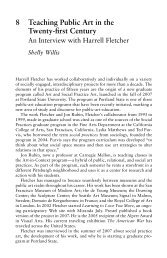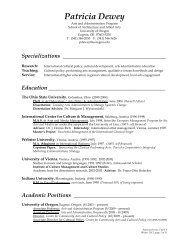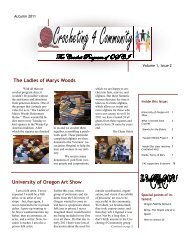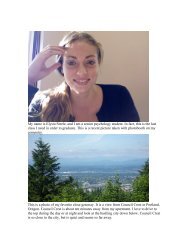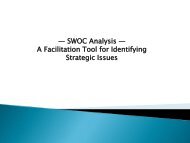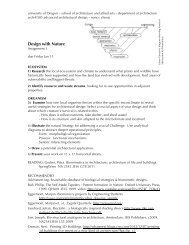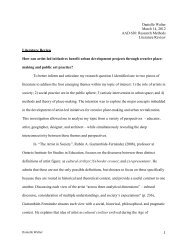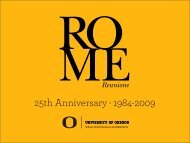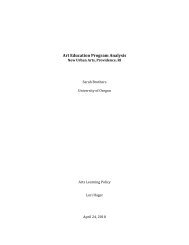Hello Neighbor: - School of Architecture and Allied Arts Blog
Hello Neighbor: - School of Architecture and Allied Arts Blog
Hello Neighbor: - School of Architecture and Allied Arts Blog
Create successful ePaper yourself
Turn your PDF publications into a flip-book with our unique Google optimized e-Paper software.
Community <strong>Arts</strong> Project Case-Study<br />
<strong>Hello</strong> <strong>Neighbor</strong>:<br />
Susan Whittaker<br />
Community <strong>Arts</strong> Praxis<br />
February 10, 2011<br />
What happens when a neighborhood undergoes rapid redevelopment?<br />
…When urban planners come in to ‘renew’ <strong>and</strong> ‘revitalize’ an existing<br />
community? …When flocks <strong>of</strong> new residents move in along with newly built<br />
condominiums, refurbished housing, <strong>and</strong> growing commerce? What happens<br />
to the mix <strong>of</strong> native on non-native residents? Gentrification is a controversial<br />
outcome <strong>of</strong> economic development, <strong>and</strong> the North Mississippi neighborhood<br />
is one <strong>of</strong> the most rapidly changing, growing, <strong>and</strong> gentrifying neighborhoods<br />
in Portl<strong>and</strong>. Today, if one were to look up information on North Mississippi<br />
one would most likely find sentiments, as one website put it: “Pros: Formerly<br />
grungy neighborhood that has bloomed; Vibrant <strong>and</strong> full <strong>of</strong> young people.<br />
Cons: Still a few rough spots” (http://portl<strong>and</strong>bridges.com).<br />
Artist, Julie Keefe, moved into this neighborhood in 1991 <strong>and</strong> over the<br />
years witnessed the morphing socio-cultural character <strong>of</strong> the neighborhood.<br />
The neighborhood still remains largely made-up <strong>of</strong> a committed sub-culture<br />
<strong>of</strong> artists <strong>and</strong> creative-types that do participate in community-building<br />
activities. But, it’s the newer consumer-type residents that typically<br />
economically push-out the native residents <strong>and</strong> previous sub-cultures that<br />
Keefe identified as her biggest concern. Following the Portl<strong>and</strong> Development<br />
Commission designating this district as an ‘Urban Renewal Area’ <strong>and</strong> the<br />
subsequent financial incentives <strong>of</strong> doing so, families who had for generations
Community <strong>Arts</strong> Project Case-Study<br />
lived in this community have since been displaced into cheaper<br />
neighborhoods. As new residents moved in, Keefe witnessed a lack <strong>of</strong><br />
cohesion. Whereas fifty years ago it was custom for residents in this<br />
neighborhood to gather in each other’s houses, share meals, for children to<br />
play <strong>and</strong> grow up together—all <strong>of</strong> that was changing. The unification <strong>and</strong><br />
comradery that had once been, had significantly grown weaker.<br />
Of course there are benefits to what is happening to Mississippi Ave.,<br />
benefits that affect the city as a whole: reduced crime rates, an increase in<br />
property values, increased tax revenues, <strong>and</strong> a tool for tourism <strong>and</strong><br />
destination marketing. But as stated on the <strong>Hello</strong> <strong>Neighbor</strong> website in an<br />
interview Keefe had with her neighbor Charles, “He didn't mind the streets<br />
being safer, the businesses returning, or the houses being fixed up. What he<br />
did mind was that people didn't say hello anymore.” The <strong>Hello</strong> <strong>Neighbor</strong><br />
project idea thus came about as a response <strong>and</strong> way to address one<br />
challenging aspect <strong>of</strong> living in a gentrified community. Through a community<br />
arts-based project, Keefe saw a way for people to start saying hello.<br />
Garnering support from Caldera, a non-pr<strong>of</strong>it arts organization, <strong>and</strong><br />
the National Endowment for the <strong>Arts</strong>, the <strong>Hello</strong> <strong>Neighbor</strong> project grew to<br />
become a statewide initiative, encompassing ten communities across<br />
Portl<strong>and</strong> <strong>and</strong> Central Oregon. The 2008 project involved middle school<br />
students who went into their communities, identifying diverse people <strong>of</strong> all<br />
ages <strong>and</strong> asking questions such as: “How do you see yourself?”; “What<br />
inspires you?”; “Can you tell me a story about the neighborhood you grew up<br />
in?”; <strong>and</strong> “Do you feel safe in your community?”. The process was
Community <strong>Arts</strong> Project Case-Study<br />
documented both by video <strong>and</strong> photographs, which then got turned into large<br />
7x5 foot banners that now hang in public community spaces. The goal, in<br />
Keefe’s words, was “to introduce the neighborhood to its children <strong>and</strong><br />
neighbors to each other." It is <strong>of</strong> amazement how seemingly simple <strong>and</strong><br />
obvious this project is, while simultaneously moving these testimonies <strong>and</strong><br />
images are, even out <strong>of</strong> context. Personally, I frequent Mississippi Ave., <strong>and</strong><br />
on numerous occasions have stopped <strong>and</strong> looked at these banners without<br />
knowing their cause or purpose—regardless they are impossible to ignore<br />
<strong>and</strong> incredibly thought-provoking. It becomes an important reminder that as<br />
we step into communities, whether just for breakfast or as an incoming<br />
resident, we remain aware <strong>of</strong> our surroundings, its past, it’s unique fabric<br />
<strong>and</strong> become a part <strong>of</strong> it. And how simple that can be, as Keefe has shown: as<br />
simple as taking interest <strong>and</strong> saying hello.<br />
Since <strong>Hello</strong> <strong>Neighbor</strong>, similar projects have sprung up. One such<br />
project is Boise Voices, a neighborhood oral history project in the larger<br />
Boise district (in which the Mississippi neighborhood is a part <strong>of</strong>). Boise<br />
Voices, created by Julie Keefe <strong>and</strong> fellow artist Apricot Irving while working<br />
together in Boise-Elliot elementary school as artists-in-residence, shadows<br />
<strong>Hello</strong> <strong>Neighbor</strong> in that process is everything. The process <strong>of</strong> connecting,<br />
sharing, <strong>and</strong> learning to bridge gaps <strong>and</strong> foster underst<strong>and</strong>ing between<br />
diverse groups, both native <strong>and</strong> non-native to a community, is powerful in<br />
<strong>and</strong> <strong>of</strong> itself. The subsequent remnants: banners, audio <strong>and</strong> video clips, the<br />
websites, interactive cultural maps, are permanent testimonials <strong>of</strong> civic<br />
dialogue <strong>and</strong> connectedness that can surface through the arts.



